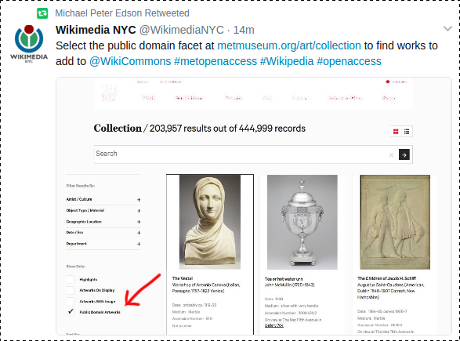Wikimedia NYC tweeted and Michael Peter Edison retweeted:
I know. Moving images from one silo to another.
But, it does increase the odds of @WikiCommons users finding the additional images. That’s a good thing.
Take a minute to visit, https://metmuseum.org/art/collection, select the public domain facet and grab an image to upload to WikiMedia Commons.
The process is quite painless, I uploaded The Pit of Acheron, or the Birth of of the Plagues of England today.
With practice it should take less than a minute but I got diverted looking for more background on the image.
Rowlandson the Caricaturist: A Selection from His Works, with Anecdotal Descriptions of His Famous Caricatures and a Sketch of His Life, Times, and Contemporaries, Volume 1 by Joseph Greco, J. W. Bouton, New York, 1880, page 112:
January 1. 1784. The Pit of Acheron, or the Birth of of the Plagues of England. —
…
The Pit of Acheron, if we may trust the satirist, is not situated at any considerable distance from Westminister; the precincts of that city appear through the smoke of the incantations which are carried on in the Pit. Three weird sisters, like the Witches in ‘Macbeth,’ are working the famous charm; a monstrous cauldron is supported by death’s-heads and harpies; the ingredients of the broth are various; a crucifix, a rosary, Deceit, Loans, Lotteries, and Pride, together with a fox’s head, cards, dice, daggers, and an executioner’s axe, &c., form portions of the accessories employed in these uncanny rites. Three heads are rising from the flames—the good-natured face of Lord North, the spectacled and incisive outline of Burke, and Fox’s ‘gunpowder jowl,’ which is drifting Westminster-wards. One hag, who is dropping Rebellion into the brew, is demanding, ‘Well, sister, what hast thou got for the ingredients of our charm’d pot?’ To this her fellow-witch, who is turning out certain mischievous ingredients which she has collected in her bag, is responding, ‘A best from Scotland called an Erskine, famous for duplicity, low art, and cunning; the other a monster who’d spurn even at Charter’s Rights.’ Erskine is shot out of the bag, crying, ‘I am like a Proteus, can turn any shape, from a sailor to a lawyer, and always lean to the strongest side!’ The other member, whose tail is that of a serpent, is singing, ‘Over the water and over the lee, thro’ hell I would follow my Charlie.’
I remain uncertain about the facts and circumstances surrounding the Westminster election of 1784 that would further explain this satire. Perhaps another day.
If you can’t wait, consider reading History of the Westminster Election, containing Every Material Occurrence, from its commencement On the First of April to the Close of the Poll, on the 17th of May, to which is prefixed A Summary Account of the Proceedings of the Late Parliament by James Hartley. (562 pages)
Rowlandson was also noted for his erotica: collection of erotica by Rowlandson.
